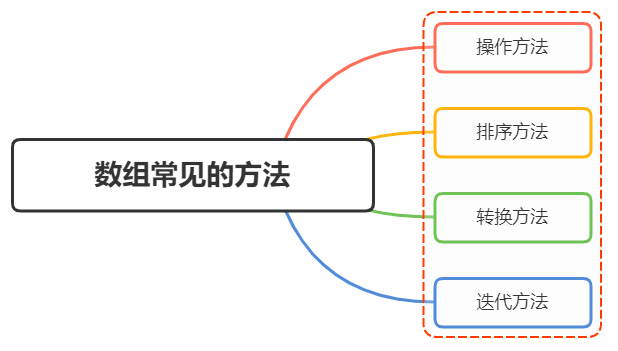数据的常用方法
面试官:数组的常用方法有哪些?

一、操作方法
数组基本操作可以归纳为 增、删、改、查,需要留意的是哪些方法会对原数组产生影响,哪些方法不会
下面对数组常用的操作方法做一个归纳
增
下面前三种是对原数组产生影响的增添方法,第四种则不会对原数组产生影响
- push()
- unshift()
- splice()
- concat()
push()
push()方法接收任意数量的参数,并将它们添加到数组末尾,返回数组的最新长度
1 | let colors = []; // 创建一个数组 |
unshift()
unshift()在数组开头添加任意多个值,然后返回新的数组长度
1 | let colors = new Array(); // 创建一个数组 |
splice
传入三个参数,分别是开始位置、0(要删除的元素数量)、插入的元素,返回空数组
1 | let colors = ["red", "green", "blue"]; |
concat()
首先会创建一个当前数组的副本,然后再把它的参数添加到副本末尾,最后返回这个新构建的数组,不会影响原始数组
1 | let colors = ["red", "green", "blue"]; |
删
下面三种都会影响原数组,最后一项不影响原数组:
- pop()
- shift()
- splice()
- slice()
pop()
pop() 方法用于删除数组的最后一项,同时减少数组的length 值,返回被删除的项
1 | let colors = ["red", "green"] |
shift()
shift()方法用于删除数组的第一项,同时减少数组的length 值,返回被删除的项
1 | let colors = ["red", "green"] |
splice()
传入两个参数,分别是开始位置,删除元素的数量,返回包含删除元素的数组
1 | let colors = ["red", "green", "blue"]; |
slice()
slice() 用于创建一个包含原有数组中一个或多个元素的新数组,不会影响原始数组
1 | let colors = ["red", "green", "blue", "yellow", "purple"]; |
改
即修改原来数组的内容,常用splice
splice()
传入三个参数,分别是开始位置,要删除元素的数量,要插入的任意多个元素,返回删除元素的数组,对原数组产生影响
1 | let colors = ["red", "green", "blue"]; |
查
即查找元素,返回元素坐标或者元素值
- indexOf()
- includes()
- find()
indexOf()
返回要查找的元素在数组中的位置,如果没找到则返回 -1
1 | let numbers = [1, 2, 3, 4, 5, 4, 3, 2, 1]; |
includes()
返回要查找的元素在数组中的位置,找到返回true,否则false
1 | let numbers = [1, 2, 3, 4, 5, 4, 3, 2, 1]; |
find()
返回第一个匹配的元素
1 | const people = [ |
二、排序方法
数组有两个方法可以用来对元素重新排序:
- reverse()
- sort()
reverse()
顾名思义,将数组元素方向反转
1 | let values = [1, 2, 3, 4, 5]; |
sort()
sort()方法接受一个比较函数,用于判断哪个值应该排在前面
1 | function compare(value1, value2) { |
三、转换方法
常见的转换方法有:
join()
join() 方法接收一个参数,即字符串分隔符,返回包含所有项的字符串
1 | let colors = ["red", "green", "blue"]; |
四、迭代方法
常用来迭代数组的方法(都不改变原数组)有如下:
- some()
- every()
- forEach()
- filter()
- map()
some()
对数组每一项都运行传入的测试函数,如果至少有1个元素返回 true ,则这个方法返回 true
1 | let numbers = [1, 2, 3, 4, 5, 4, 3, 2, 1]; |
every()
对数组每一项都运行传入的测试函数,如果所有元素都返回 true ,则这个方法返回 true
1 | let numbers = [1, 2, 3, 4, 5, 4, 3, 2, 1]; |
forEach()
对数组每一项都运行传入的函数,没有返回值
1 | let numbers = [1, 2, 3, 4, 5, 4, 3, 2, 1]; |
filter()
对数组每一项都运行传入的函数,函数返回 true 的项会组成数组之后返回
1 | let numbers = [1, 2, 3, 4, 5, 4, 3, 2, 1]; |
map()
对数组每一项都运行传入的函数,返回由每次函数调用的结果构成的数组
1 | let numbers = [1, 2, 3, 4, 5, 4, 3, 2, 1]; |